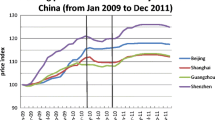Abstract
This paper analyzes the determinants of housing prices in Hong Kong by using property transaction data of condominium units from Taikoo Shing, one of the largest real estate properties in Hong Kong. We use a hedonic pricing model for the empirical analysis and estimate the model by using the Box-Cox quantile regression method. The empirical results show that this method provides a more comprehensive description of housing price determinants. Housing prices and characteristics have a nonlinear relationship, and this relationship varies across all quantiles. In addition, the response of housing prices to various housing characteristics varies across quantiles. For example, an increase in the size of the gross floor area is more valued at higher quantiles. Other variables have differential effects on housing prices across the distribution of housing prices. We also perform a simple simulation for model predictability and show that our model outperforms other models which have been frequently used in the previous studies.



Similar content being viewed by others
Notes
‘MTR’ is the abbreviation for ‘Mass Transit Railway’, the rapid transit railway system in Hong Kong.
See Koenker (2005) for an excellent comprehensive survey of quantile regression methods.
For an in-depth discussion on the indicator function and \(\mathbb {N}_{\tau ,n}\), see Fitzenberger et al. (2009).
In the empirical analysis, all results are computed using the R software. Program codes are available upon request.
A complex is defined as a cluster of high-rise buildings which have inter-connected lower level floors, often used for retail, businesses or parking.
In Hong Kong, developers use a naming convention in which “garden” and “terrace” are commonly used to name residential communities.
As shown in Fig. 1, the green box with the word ‘EXIT’ on it indicates an exit of the MTR station.
We also estimate the semi-log linear model. The empirical results are quite similar to those of the linear model. To save space we do not report the empirical results. The results are available upon request.
Bera et al. (2013) develop a new estimator which corresponds to the conditional mode of the asymmetric Laplace distribution. Moreover, the estimated quantile level (\(\hat {\tau }\)) turns out to be the most informative quantile level in a framework of information-theoretic approach. See Bera et al. (2013) for more details.
References
Bao, X.H., & Wan, A.T.K. (2004). On the use of spline smoothing in estimating hedonic price models, empirical evidence using Hong Kong data. Real Estate Economics, 32(3), 487–507.
Bera, A.K., Galvao, A.F., Montes-Rojas, G.V., Park, S.Y. (2013). Asymmetric laplace regression, maximum likelihood, maximum entropy and quantile regression. Working Paper, University of Illinois, Urbana-Champaign.
Box, G. EP., & Cox, D. R. (1964). An analysis of transformations. Journal of the Royal Statistical Society. Series B (Methodological), 26(2), 211–252.
Buchinsky, M. (1995). Quantile regression, Box-Cox transformation model, and the U.S. wage structure, 1963–1987. Journal of Econometrics, 65, 109–154.
Edmonds, R. G. (1985). Some evidence on the intertemporal stability of Hedonic price functions. Land Economics, 61(4), 445–451.
Ekeland, I., Heckman, J., Nesheim, L. (2002). Identifying hedonic models. American Economic Reviews, 92(2), 304–309.
Ekeland, I., Heckman, J., Nesheim, L. (2004). Identification and estimation of Hedonic models. Journal of Political Economy, 112(S1), S60–S109.
Fitzenberger, B., Wilke, R. A., Zhang, X. (2009). Implementing Box-Cox quantile regression. Econometric Reviews, 29(2), 158–181.
Follain, J. R., & Jimenez, E. (1985). The demand for housing characteristics in developing countries. Urban Studies, 22(5), 421–432.
Haupt, H., Schnurbus, J., Tschernig, R. (2010). On nonparametric estimation of a Hedonic price function. Journal of Applied Econometrics, 25(5), 894–901.
Kaufman, D., & Quigley, J. M. (1987). The consumption benefits of investment in infrastructure: The evaluation of sites-and-services programs in underdeveloped countries. Journal of Development Economics, 25(2), 263–284.
Koenker, R. (2005). Quantile regression. Cambridge University Press.
Koenker, R., & Bassett, G. (1978). Regression quantiles. Econometrica, 45(1), 33–50.
Linneman, P. (1980). Some empirical results on the nature of the Hedonic price function for the urban housing market. Journal of Urban Economics, 8(1), 47–68.
Mak, S., Choy, L., Ho, W. (2010). Quantile regression estimates of Hong Kong real estate prices. Urban Studies, 47(11), 2461–2472.
Megbolugbe, I. F. (1989). A Hedonic index model: The housing market of Jos, Nigeria. Urban Studies, 26, 486–494.
Mok, H. MK., Chan, P. PK., Cho, Y. S. (1995). A Hedonic price model for private properties in Hong Kong. Journal of Real Estate Finance and Economics, 10(1), 37–48.
Parmeter, C. F., Henderson, D. J., Kumbhakar, S. C. (2007). Nonparametric estimation of a Hedonic price function. Journal of Applied Econometrics, 22, 695–699.
Powell, J. (1991). Estimation of monotonic regression models under quantile restrictions. In W. Barnett, J. Powell, G. Tauchen (Ed.), Nonparametric and semiparmetric methods in economics (pp. 357–384). New York: Cambridge University Press.
Zahirovic-Herbert, V., & Chatterjee, S. (2012). Historic preservation and residential property values: Evidence from quantile regression. Urban Studies, 49(2), 368–382.
Zietz, J., Zietz, E. N., Sirmans, G. S. (2008). Determinants of house prices: A quantile regression approach. Journal of Real Estate Finance and Economics, 37(4), 317–333.
Acknowledgments
We are grateful to the editor and two anonymous referees for their valuable comments. However, we retain the responsibility for any remaining errors.
Author information
Authors and Affiliations
Corresponding author
Rights and permissions
About this article
Cite this article
Kim, HG., Hung, KC. & Park, S.Y. Determinants of Housing Prices in Hong Kong: A Box-Cox Quantile Regression Approach. J Real Estate Finan Econ 50, 270–287 (2015). https://doi.org/10.1007/s11146-014-9456-1
Published:
Issue Date:
DOI: https://doi.org/10.1007/s11146-014-9456-1




